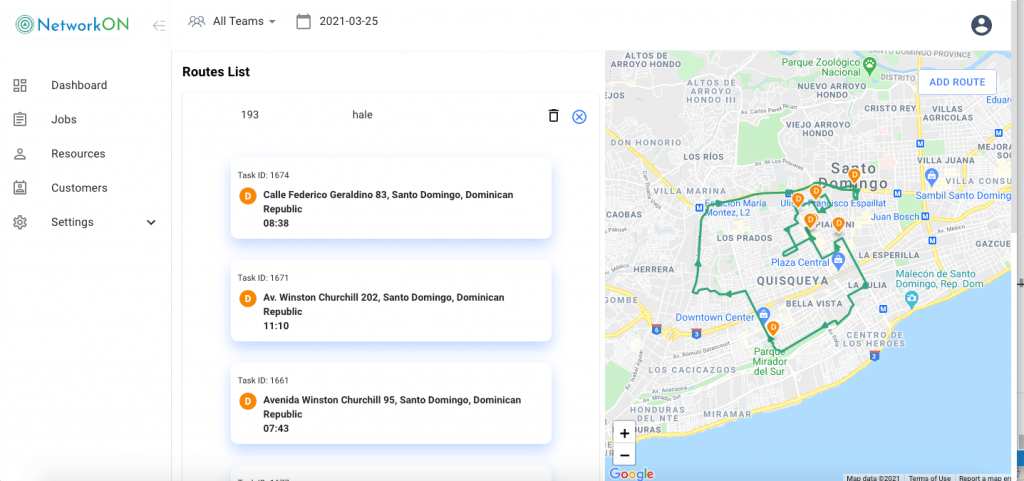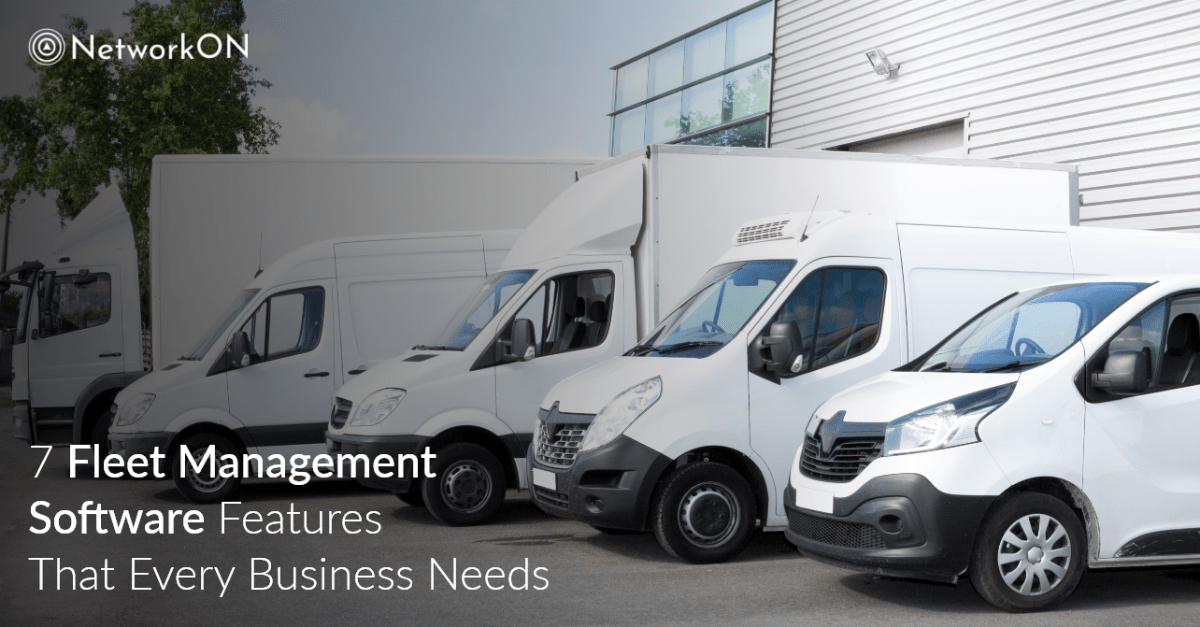Table of Contents
As more customers prefer to purchase online, retailers and logistics providers are looking for new ideas to deliver goods to the end purchaser.
Fleet management software helps you manage drivers, dispatchers, and vehicles to reduce costs and increase fleet’s productivity. Though every business organization requires specific makeup of fleets, it calls for dynamic capabilities from a fleet management software.
Let’s begin
7 fleet management software features
1. Real-time visibility
When companies look for better technology to manage their fleet—their main aim is to improve the visibility of each activity in real time. It includes vehicle tracking through GPS to know where each order is, or if it is with your fleet or a contractor’s driver.
With fleet tracking, all the relevant stakeholders, including fleet managers, dispatchers, shippers, and the end customers can check a driver’s location in real-time.

Visibility is even more important when a business is aiming to scale its delivery. Since profitability will only come from growth-a cloud-based fleet management software ensures that your control and visibility don’t reduce when you expand your geographic reach or add more fleets.
2. Driver management capabilities
Exercising control over your drivers enables you to track their movement and check if the deliveries are made on time. Whether your fleets are external or internal, driver management capabilities are pivotal to streamline the workflow of your organization.
Here’s what it includes:
- Evaluating driver earnings
- Driver and delivery scheduling
- Tracking and analyzing performance benchmarks and various KPIs
- Permission management
A centralized dashboard is a key fleet management software feature. It allows your fleet managers and you to get accurate status updates for delivery, manage schedules, vehicle capacity, and driver performance.
Since business intelligence is a quintessential part of fleet management, the software also needs efficient reporting tools as well.
3. Scalable and full-scale integration
One of the major reasons that many businesses fail to implement new technology is the concern that it will replace their existing systems and increase overhead costs. That is why it’s important to identify fleet management software that seamlessly integrates with your existing systems across the supply chain.
It involves gathering data from transport management systems, external fleets, WMS, and other systems and managing it from a single platform to ensure optimal visibility and allowing managers to get insights into better decision making.
In addition to being compatible with your existing systems, the fleet management software must also be flexible enough to readily adapt to your specific business requirements.
For instance, if you want your dispatchers to be able to enter specific data on each delivery run, or specify how many orders will go out in a single delivery run—the fleet management software should enable this degree of customization.
To ensure scalability, the best fleet management software should allow you to easily increase the number of fleets, drivers, or orders at any given time. This capability will be extremely important in peak seasons when your success depends on how quickly you can launch new delivery services into new regions.
And to resolve any fleet management challenges, the platform should enable the following considerations:
- Swift integration with and onboarding of new fleets
- Rapid expansion through new area codes and locations
- Quick launch of services like same-day delivery, installations, and assembly
4. Fleet dispatch and planning software
The core function of fleet management software is to help you decide which orders go to which fleet and when. However, there’s much more than that.
- Vehicle management: Optimal delivery involves vehicle availability and the knowledge to select the best vehicle suited for delivery. For instance, some deliveries may need a vehicle with special capabilities like refrigeration or heating, while others may require an inert chamber to supply medicines and high-grade electronics.
- Optimized routing and route management: With route optimization software, you can decide which route is most favorable based on a variety of constraints. By using real-time data sync capabilities, the software accurately applies the constraints and comes out with the optimal route per vehicle.
5. Machine learning
Data plays a pivotal role in delivering optimal fleet performance by resolving different fleet management challenges. Hence, data acquisition is important—on both macro and micro levels.
Fleet management systems that can apply historical data to machine learning to create analytics like time to base, time on site, vehicle unloading time, and more can fill the gaps in fleet efficiency and help you make more informed decisions to plan deliveries.
The benefits of machine learning just don’t end there, it also speeds up delivery times and improves the reliability of delivery estimates that improve the overall customer experience and brand loyalty.
6. Driver performance and retention solutions
Driver turnover and retention are some of the prominent issues in the trucking industry. As per a survey in 2018, 69% of the executives admitted that driver recruitment was their biggest challenge.
The task of onboarding skilled drivers can be hectic and can take as long as up to six months. Thus, improving driver retention rates becomes a critical component of any fleet management software.
An appropriate fleet management software has to be user-friendly and equipped with efficient automation of delivery flows and task management so that drivers can see when they need to scan an item, collect signatures or perform other activities.
7. Driver safety and telematics software
Following optimal measures to ensure driver safety not only safeguards the people performing your deliveries but also lowers your insurance costs.
As per a survey, 86% of modern fleets now use fleet management software for their efficient and cost-effective capabilities, and to streamline work operations and monitor driver behavior.
Fleet management software integrated with telematics solutions can monitor vehicle speed, frequency of driver breaks, and other data that can be used to rate how safely someone drives.
You can use this information for gamification and reward those drivers who rank the best in terms of safety and traffic regulations.
Takeaway
Fleet management is more than managing fleets and vehicles, as it takes into consideration a multitude of factors. The good news is, you can get easily get started on your journey towards effective fleet management without having to acquire all the resources from scratch.
With the right partner like NetworkON, you get all the necessary elements with fully-featured fleet management services at your fingertips. To learn more about how our fleet management software can help you turbo-charge your business operations and boost productivity, connect with us at info@networkon.io or visit our website.
Frequently Asked Questions:
What is the primary goal of fleet management software?
The primary goal of fleet management software is to help businesses manage drivers, dispatchers, and vehicles efficiently to reduce costs and increase productivity.
Why is real-time visibility a crucial feature in fleet management software?
Real-time visibility is crucial in fleet management software. It allows stakeholders such as fleet managers, dispatchers, shippers, and end customers to track a driver’s location in real-time, ensuring better control and scalability of delivery operations.
What are the key components included in driver management capabilities?
Driver management capabilities encompass evaluating driver earnings, driver and delivery scheduling, tracking and analyzing performance benchmarks and various KPIs, and permission management. These components streamline the organization’s workflow.
How does fleet management software address concerns about system integration and scalability?
Fleet management software should seamlessly integrate with existing systems across the supply chain and be flexible enough to adapt to specific business requirements. It should allow swift integration with new fleets, rapid expansion, and quick launch of services, ensuring scalability during peak seasons.
What role does machine learning play in fleet management software?
Machine learning in fleet management software leverages historical data to create analytics, improving fleet efficiency. It enhances delivery times, reliability of estimates, and overall customer experience, making informed decisions for planning deliveries.
Why is driver performance and retention a crucial aspect of fleet management software?
Driver turnover and retention are significant challenges in the trucking industry. Fleet management software should offer user-friendly interfaces, efficient automation of delivery flows, and task management to improve driver retention rates and streamline onboarding processes.





Create Personal Account
Thank you for your sharing. I am worried that I lack creative ideas. It is your article that makes me full of hope. Thank you. But, I have a question, can you help me?